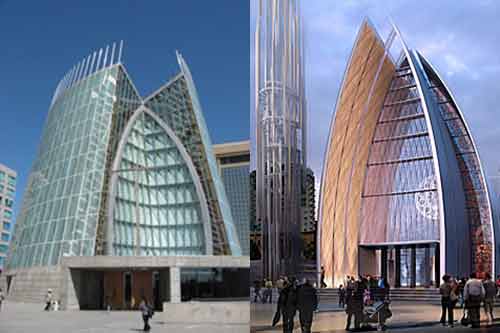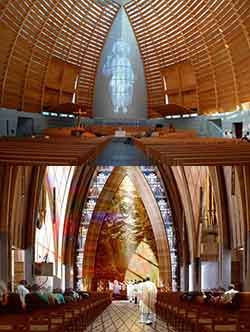
The Saturday Press (Christchurch’s newspaper) had a full-page article about the Christ the Light Roman Catholic cathedral in Oakland, California, and its influence on the exterior look of the contemporary option (called “Option 3”) for an Anglican cathedral in the centre of Christchurch. Oakland’s cathedral was one visited by the Christchurch study tour. I agree with the article that Option 3 looks “most likely to proceed”.
The whole article is worth a read. I will merely highlight some similarities and differences between Oakland’s cathedral and Christchurch’s contemporary plan (Option 3).

Christchurch’s Madonna & Child
Similarities
- Oakland’s century-old neo-gothic cathedral was damaged by quakes.
- Curving; glass and concrete; timber interior.
- Oakland has a massive image of Christ – Option 3 presents a massive image of the Madonna and Child.
- The footprints are comparable.
- Both seek to be places where people of all faiths are welcome.
Differences
- Oakland diocese held an international competition.
- Oakland’s cathedral is designed from the inside out “with the circle as the organising geometry. This is where the Oakland design departs from Christchurch’s: with a circular structure, the architect put the congregation around the altar “as one community”. This evolved out of current Catholic liturgy, [Hartman, the architect] explained. The Second Vatican Council promoted the creation of community through church design. The traditional cross layout, which Christchurch keeps, was dropped for a fish-shaped floorplan, referencing the symbol used by very early Christians.”
- Oakland’s cathedral includes “a conference centre, bishop’s centre and diocesan offices”.
- Oakland’s cathedral places the significant font centrally as one enters the worship space.

You can read more about the Christchurch cathedral options here and here. Especially about ways I think that Option 3 can be improved. You can, of course, leave comments here, as usual. If you want to give your opinion directly to those making the Christchurch cathedral decisions, go to Cathedral conversations.
If you appreciated this post, there are different ways to keep in touch with the community around this website: like the facebook page, follow twitter, use the RSS feed,…



The Cathedral of Christ the Light in Oakland is absolutely stunning. I spent some hours there and I’ve never been in a more beautiful liturgical space, BUT, I’m reliably informed the acoustics are terrible for spoken word – so many things for sound to bounce off and reverberate. Good for organ I suspect, but rotten to read or preach in. Which basically makes it a very beautiful version of St Paul’s Wellington:)
So basically, don’t skim on the acoustical engineers in the design and building process.
When you speak of Oakland’s being a beautiful liturgical space, are you including the configuration of the ground-plan, Brian? I am hoping (suspecting) you are. Christchurch’s Option 3 is (as you read on my other posts) essentially the cruciform ground-plan of the 19th century cruciform version we had (aeroplane formation for seating, font in one corner,…). If we progress with that IMO it is a hugely lost opportunity.
Readers here who do not know Brian’s mention of the Wellington cathedral – when I have been there it is difficult to know whether Latin, Elizabethan English, or Te Reo Maori is being used. It is not possible to ascertain what the choir is chanting without the text in front of you. I do not know of any place that places such a low value on the verbal component of liturgy. I cannot believe that Oakland’s could be anything like that, and would be horrified if Christchurch acoustics were anything like this. I do not know about acoustical expertise here – in my experience there’s usually a lot of trial and error – put the building up and then try and fix its problems 🙁
Christ is risen.
Absolutely I include the floor plan Bosco, including the creative inclusion of side chapels and meditation space – that along with the wood and incredible amount of light makes this a stunning piece of architecture. Ironically I suspect it is precisely that architecture (with lots of wooden slats and glass) that causes the acoustic issues. I wasn’t fortunate enough to attend a service myself, but it’s obvious just walking around how much bounce there is – every footstep echoes.
The ‘build and then sort it out’ approach is very poor use of resources IMO. That’s what they had to do in Auckland of course, which led to the infamous lotus flower acoustical panel hanging from the ceiling. Including a professional acoustical engineer (the sort of people who design concert hallsand lecture theatres) in the design and build process will save a huge amount of time and money later.
BTW, you ain’t heard nothing til you’ve heard a jazz band trying to work within the St Paul acoustics – truly an exercise in harmonic anarchy!
As the Press article, Brian, calls Christchurch’s Option 3 Oakland’s “little brother” one hope might be that our interior/floorplan (with the improvements you point out) might better express what the exterior tantalisingly promises (but then IMO does not fulfil). My questioning why the 19th century footprint is being retained has been met with the response that there are certain (publicly undisclosed) “covenants” on the land which prevent a more creative/contemporary liturgically-useful/usable floorplan. Hence my suggestion of Option 3B – a minor variant with huge benefits for the purpose for which the building will be put up: worship. At our synod we were told that we need to make strategic decisions and the legal changes needed can follow from that. It seems that the cathedral planners have sadly not followed this approach. Christ is risen.
Interesting. It was always the echo-y nature of the cathedrals in Britain which created their atmosphere and uniqueness.
I have spent many happy hours wandering with my footfall amidst garbled liturgy or plainsong.
Do we really need to hear the words/voice of preachers to be touched spiritually? I’ve found many times it’s distracting from a religious experience- there are very few people who I want to listen to too closely! Rather ‘I will incline my ear to a proverb; I will solve my riddle to the music of the lyre.’
Let them print their words this day and age who would stand by them!
And so much of church music is best heard in these weird ancient acoustic settings…
Don’t worry Bosco, all will be well I am sure.
I’m Originally from Oakland, and did most of my Liturgical training in the Old St. Francis de Sales Cathedral. Prior, it had been my mothers Parish before becoming the Cathedral. (I attended JSTB) As one with a degree in Liturgy, I find the New Cathedral Cold, sterile, & uninspiring. They will spend thousands more, on refitting its acoustics. In my opinion, it is a monument to bp.
Cordelions’ Ego. Dark and uninspiring. Even the Crypt is uninspiring. The ruff concreat walls, when scantified at it’s Consecration, still years latter, show the sloppy Job of their anointing, with greasy oil stains Sloppily applied with a rag Mop. These Walls needed to be sealed.
I have seen other churches that used a boat motif, this one, you cant tell if it’s standing on end or upside down! it is disorienting.
The Risen Christ appears to be a Hologram, and is just black & White. It is not always visible. A stain-glass representation of the original, would have created a wonderful focus point an warmed up th entire structure. As it stands, it is equally uninspiring.
Only the Asian side chapel had any life to it. The tapestries and festive banners gave the room warmth and style.
The Cathedra, and seating for the clergy/servers belongs in a Roman Basilica. I feel, it is not appropriate to this modern structure.
It is my hope, that your new cathedral will avoid hype and modernism for its own sake and make it a place of worship that is welcoming and helps the people celebrate their faith joyfully. +neil
Thanks, Bishop Neil, for your thoughtful, helpful comments. Christ is risen.
Your Excellency,
I agree with much of your thoughts on the aesthetics of the cathedral [I live in the Oakland Diocese]. However, I would not put its failings at the foot of now-Archbishop Cordileone. +Cordileone had nothing to do with the design or construction of the cathedral, as he was not appointed to Oakland until 2009, the year after the cathedral was consecrated and dedicated. Design (2000-2005) was started under Bishop-emeritus John Cummins, while final design and construction (2005-2008) occurred under now-Abp Allen Vigneron.
— Richard